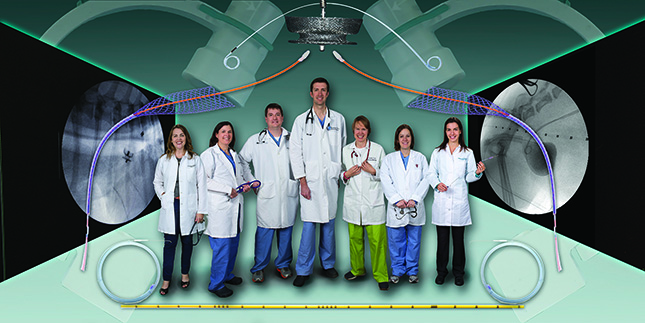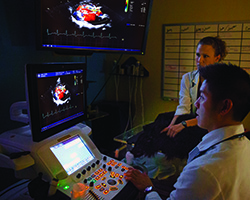Collaboration, Innovation Key to Team’s Success

The Guidewire Group doesn’t believe in hopeless cases. Made up of practitioners from across the Texas A&M College of Veterinary Medicine & Biomedical Sciences (CVM) to evaluate rapidly evolving medical techniques and to collaborate on challenging veterinary cases, the group harnesses the diverse skills of its members to develop and provide new treatments for animals that might appear to be out of options.

Formed in 2014, the group has members that include cardiologists, surgeons, criticalists, and internists. Their focus is on improving animal care through creativity, innovation, and-most of all-collaboration.
“It’s an incredibly collaborative process, because it pulls skills from different specialties in this really integrated system,” said one of the team’s founders, Dr. Audrey Cook, internist and associate professor at the CVM. “We’ve got great facilities here and a great team, but this is the first time that we’ve sat down and thought, ‘Let’s actually get a formal group of people from different fields and with different areas of expertise to work together on challenging patient problems and be really integrated.'” This culture of collaboration is not only embraced for practitioners in the immediate area but also extends to veterinarians at training facilities or practicing in other states.
The mission
The practice of veterinary medicine evolves rapidly, and the Guidewire Group aims to be at the forefront of effective treatments for patients with seemingly little chance of survival and to lead the way in innovative animal care by providing help, hope, and a better quality of life.
The group is offering solutions for kidney, bladder, liver, heart, and airway problems that were unmanageable as recently as 10 years ago. These new treatments can often make a huge difference, such as sparing the kidney in patients for which the only other option would have been removal of the organ.
Many of the patients the Guidewire Group sees have been diagnosed with cancer. Cook points to the example of dogs with transitional cell carcinoma of the urinary bladder, which often makes the animal unable to urinate. The Guidewire Group works together to insert a small device called a stent into a dog’s urethra to open a way for the urine to escape.
“In the old days, we used to place tubes through the body wall into their bladders, and it was just awful,” Cook remembered. “Now, we put in these little tiny devices that hold the urinary tract open. The dogs go home, and they can enjoy months of comfortable time that would otherwise not have been possible.”
The work of the Guidewire Group is not just about treating cancer patients. They offer many new approaches for a variety of serious problems, such as a disease causing blood loss from the kidneys. In the past, veterinarians would have removed the kidney to stop the bleeding. However, for dogs with bleeding from both kidneys, removal is not an option. The Guidewire Group now has a solution.
One day a young dog suffering from an invariably terminal kidney disease arrived at the hospital, and the Guidewire Group spent months developing a new approach to his treatment. “We tried this really novel procedure on the dog, where we placed catheters in and cauterized the kidneys. Six weeks later, he was completely cured,” Cook said. “A three-year-old dog, given back his life. We were overjoyed with the results. He had a condition that was an absolute death sentence even four or five years ago. To have that kind of success is really, really exciting.”
An all-star team
After graduating with distinction from the Royal School of Veterinary Studies at the University of Edinburgh, Scotland, in 1989, Cook held an internship in Small Animal Medicine and Surgery at North Carolina State University’s College of Veterinary Medicine. She then spent three years at the University of California at Davis College of Veterinary Medicine as a resident in small animal internal medicine.
In 1994 she became a diplomate in the American College of Veterinary Internal Medicine, and in 1996 she was named a diplomate in the European College of Veterinary Internal Medicine. She spent 10 years in private practice in Newport News, Virginia, before joining the faculty at Texas A&M.
The Guidewire Group’s all-star lineup is key to its success. Among them, the team has well over 100 years of experience in specialty veterinary care.
Aside from Cook, other members of the core team include Dr. James Barr (criticalist), Dr. Jacqueline Davidson (surgeon), Dr. Sonya Gordon (cardiologist), Dr. Jonathan Lidbury (internist), Dr. Kelly Thieman Mankin (surgeon), Dr. David Nelson (emergency room doctor and surgeon), Dr. Medora Pashmakova (criticalist), and Dr. Ashley Saunders (cardiologist).
Drawing on other medical fields
Cook said most of the group’s cutting-edge treatments actually had their start in human medicine. The techniques have to be scaled down, but they are based on philosophies developed in the human medical field.
“Typically, people thought in terms of trying something first on an animal; if it works, you can use it on a person,” Cook said. “Here, we’re looking at human medicine success stories and using the same techniques on our animals. It’s tough. Things have to be scaled down and resized. In these cases, the human is the metaphorical guinea pig.”
The team tweaks many procedures to fit patient needs by integrating its combined knowledge based on a “huge foundation” of medical research and practice already underway. For instance, Texas A&M’s cardiology team is known around the world for inventing devices and developing new procedures, and the Guidewire Group often uses these innovative cardiac approaches to creatively treat non-cardiac organs. The Guidewire Group’s cardiologists, Drs. Gordon and Saunders, have been invaluable in bringing that knowledge to the table. Even though a patient might have a liver or urinary tract problem, some of the techniques of interventional cardiology can apply to the treatment. “It is a question of pulling skills from other areas,” Cook said.
Some members of the group have worked with other leading veterinary medicine teams in their application of human medical methods to animals. A successful group in northeastern New York has been a pioneer in this practice, according to Cook. “They trained with human teams and then brought these methods to the veterinary world,” Cook said, adding that members of pioneering teams or their protégés have trained her and most of her team members in these techniques.

Spreading the word

The team is eagerly working to spread the word about its research and welcomes emails, calls, and visits from veterinarians with questions about unusual or difficult cases.
“That way, we can at least say, ‘Yes, we do this,’ or ‘No, we don’t, but we can make some calls and find out if anyone else can,'” Cook said.
Cook said it’s always heartbreaking to learn about situations in which veterinarians were unaware of new treatment options for their patients and tried other treatments that are less successful-or worse, told their clients that nothing could be done. Getting the word out on new procedures is something about which the Guidewire Group is passionate. It’s been looking for ways to bring awareness of its new treatments.
“I’ll bump into veterinarians and they’ll say, ‘I heard you did something cool on somebody else’s patient,'” Cook said. “They’ll say, ‘I had a dog like that six months ago. I didn’t even think to call.'”
As veterinary treatments evolve rapidly, veterinarians-even recent graduates-need to be aware that techniques may be available that weren’t around when they were in school. “What we couldn’t do even five years ago, we can do today,” Cook said. “Even if you’ve never heard of it or ever seen it doesn’t mean that it’s not possible.”
Cook said she hopes that all veterinarians will think that “nothing can be done” less often, even when that may have previously been the case, as the Guidewire Group could hold the key to a cure.
“I hope they will say, ‘Let me call the Guidewire Group first,'” Cook said. “‘I want to make sure there’s not a method I’ve not heard of,’ before they say, ‘It’s hopeless. I’m sorry.’ I hope they will take two minutes to shoot us an email or pick up the phone and find out what options there might be.”
The Guidewire Group has a short slide presentation that its members are eager to present to as many practitioners as possible. “If I’m going somewhere to talk about endocrine disease, for example, and everyone is just digging into their chicken and coleslaw, I’ll say, ‘Just for six minutes, I’m going to tell you something really cool that we’re now able to do,'” Cook said.
If there are even a few veterinarians in a room for a continuing education event, for instance, Cook and her team members always speak to the coordinator and ask for five minutes. They show pictures of the procedures and before-and-after shots. “We’re trying to catch people when they’re in a chair and they can’t get away,” Cook said.
Ultimately, Cook and the rest of the team want veterinarians to know that advances in medicine are creating new options for patients that would have been considered hopeless in the past. “These techniques have solved problems,” Cook said. “We actually have solutions now for previously devastating diseases, and that is the best news for everyone.”
Reaching out:
To contact the Guidewire Group, send an email to guidewire@cvm.tamu.edu or contact the Small Animal Hospital at (979) 845-2351.


